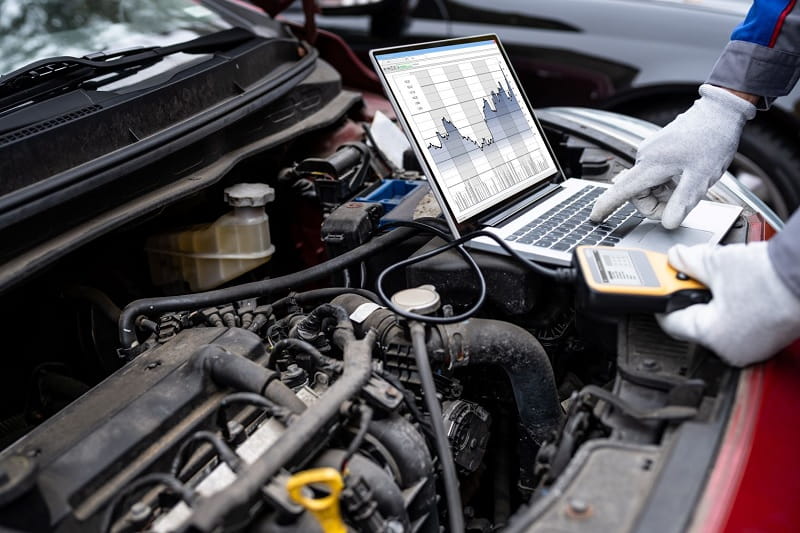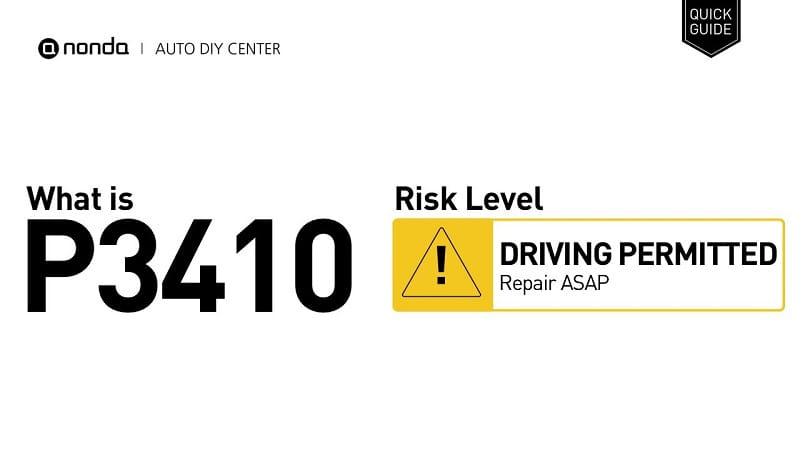This post contains affiliate links. This means I will make a commission at no extra cost to you should you click through and make a purchase [ “As an Amazon Associate, I earn from qualifying purchases.” ]. Read the full disclosure here.
Understanding DTC P3410: Cylinder 2 Deactivation/Intake Valve Control Circuit Performance GuideMechanic.Com Modern vehicles are increasingly reliant on advanced technologies to optimize fuel efficiency, engine performance, and emissions.
One of these technologies is cylinder deactivation, often found in vehicles equipped with Active Fuel Management (AFM) or Displacement on Demand (DoD).
These systems allow the engine to deactivate specific cylinders when full power isn’t needed—typically during light-load conditions.
However, like any advanced system, AFM relies on precise control circuits to function correctly. If there is a performance issue in one of these circuits, the vehicle’s Powertrain Control Module (PCM) or Engine Control Module (ECM) will trigger a Diagnostic Trouble Code (DTC) to alert the driver or technician of a problem. One such code is P3410: Cylinder 2 Deactivation/Intake Valve Control Circuit Performance.
This article explores the meaning of this code, what causes it, symptoms to watch for, and how to properly diagnose and fix the issue.
P3410 Cylinder 2 Deactivation/Intake Valve Control Circuit Performance
What Does DTC P3410 Mean?

DTC P3410 refers to a performance issue within the intake valve control circuit responsible for the deactivation of cylinder 2.
Unlike “open” or “short” circuit faults, a “performance” DTC means that the circuit is physically connected, but it is not operating within expected parameters. This could be due to sluggish response, incorrect voltage levels, restricted oil flow, or mechanical binding.
In vehicles with AFM/DoD, solenoids control oil flow to special lifters that collapse to deactivate the cylinder. If the PCM detects that cylinder 2 is not deactivating or reactivating as commanded—despite the circuit being electrically intact—it logs the P3410 code.
Cylinder Deactivation System Overview
To fully understand P3410, it helps to briefly explain how cylinder deactivation works:
Normal Operation (V8 Mode)
All cylinders fire, and both intake and exhaust valves operate normally.
Deactivation Mode (V4 Mode)
Under light load, the PCM sends a command to deactivate cylinders—typically 1, 4, 6, and 7 or some variation depending on the engine. It does this by:
- Activating solenoids that direct oil pressure to hydraulic lifters.
- These lifters collapse, preventing valve operation in the selected cylinders.
- Fuel injection and spark are also disabled.
Cylinder 2’s intake valve must function reliably within this system. If the PCM detects sluggish response, unexpected pressure, or poor timing, it sets P3410.
P3410 Cylinder 2 Deactivation Intake Valve Control Circuit Performance
Symptoms of P3410
Drivers and technicians may notice several symptoms when DTC P3410 is active, including:
- Check Engine Light (CEL) illuminated.
- Decreased fuel economy, due to AFM being disabled.
- Rough idle or hesitation, especially when switching modes.
- Reduced engine power, often during acceleration.
- Abnormal engine noise, such as ticking or tapping sounds.
- Failure to switch between V8 and V4 mode.
These symptoms vary depending on whether the valve remains stuck open, closed, or is simply responding too slowly.
P3410 Cylinder 2 Deactivation Intake Valve Control Circuit Performance
Common Causes of DTC P3410

Several issues can cause the PCM to log a P3410 code. The most common include:
1. Faulty Intake Valve Control Solenoid (Cylinder 2)
If the solenoid that controls oil flow to the intake lifter of cylinder 2 is sticky, worn, or electrically weak, the circuit may respond improperly.
2. Oil Quality or Contamination
Old, dirty, or incorrect oil can cause lifters and solenoids to function poorly. Oil sludge can block passages or create delay in lifter collapse.
3. Restricted Oil Passages
Sludge buildup inside the engine can restrict oil flow, affecting the timing and performance of the valve control mechanism.
4. Weak Hydraulic Lifter (Cylinder 2)
A worn or leaking lifter may not respond accurately to oil pressure commands, leading to performance issues.
5. Electrical Issues
Although not a full open or short circuit, high resistance, corroded connectors, or poor grounds can affect circuit timing or power delivery.
6. PCM Software or Driver Fault
Occasionally, a PCM update or reprogramming may be required if the driver circuit behaves inconsistently or a software calibration issue is found.
P3410 Cylinder 2 Deactivation Intake Valve Control Circuit Performance
Diagnosing P3410
Diagnosing this code requires a combination of mechanical, electrical, and fluid system checks. Here’s a step-by-step guide:
1. Scan for Codes and Freeze Frame Data
Confirm the presence of P3410 and note the operating conditions (RPM, temperature, load) when the code was set.
2. Visual Inspection
Check solenoid wiring and connectors for signs of wear, damage, corrosion, or loose fit.
Look for oil leaks around the solenoid or valve cover area.
3. Check Oil Level and Quality
Inspect the dipstick for proper oil level.
Evaluate oil color and smell. Dark, thick, or burnt-smelling oil should be replaced.
Replace oil and filter with the manufacturer-recommended type and viscosity if needed.
4. Test the Solenoid
Use a multimeter to test resistance and continuity of the intake valve control solenoid.
Apply 12V to the solenoid using a jumper (if safe) to check for actuation.
5. Monitor Solenoid Function with a Scan Tool
Use bi-directional control (if supported) to command the solenoid on/off and verify whether cylinder 2 responds appropriately.
6. Oil Pressure Test
Low or erratic oil pressure can prevent the system from functioning. Test pressure at idle and under load to ensure consistent delivery.
P3410 Cylinder 2 Deactivation Intake Valve Control Circuit Performance
Fixes for DTC P3410

Once you’ve identified the root cause, possible fixes include:
- Replacing the cylinder 2 intake valve control solenoid
- Cleaning or replacing dirty or contaminated engine oil
- Flushing oil passages (if blockage is suspected)
- Replacing worn or sticking lifters
- Repairing wiring harness or connectors with high resistance
- Updating or reflashing the PCM
After completing repairs, clear the code using a scan tool and test drive the vehicle. The code should not return if the issue has been resolved.
P3410 Cylinder 2 Deactivation Intake Valve Control Circuit Performance
Vehicles Commonly Affected by P3410
P3410 is most often associated with General Motors (GM) vehicles that use AFM/DoD systems. These include:
- Chevrolet Silverado
- GMC Sierra
- Chevrolet Tahoe
- GMC Yukon
- Chevrolet Suburban
- Cadillac Escalade
Typically, the affected engines are 5.3L, 6.0L, or 6.2L V8s with cylinder deactivation.
Preventing DTC P3410
To reduce the risk of experiencing P3410 in the future, follow these best practices:
- Perform regular oil changes using only the recommended viscosity and type.
- Avoid prolonged idling, which can lead to oil contamination and lifter wear.
- Inspect wiring and connectors during routine maintenance for signs of wear.
- Address Check Engine Lights promptly, before small issues evolve into larger ones.
- Use quality oil filters, as poor filtration can accelerate lifter and solenoid damage.
Conclusion
DTC P3410: Cylinder 2 Deactivation/Intake Valve Control Circuit Performance indicates that the intake valve control system for cylinder 2 is not functioning within expected performance standards. This doesn’t mean a complete failure—but rather that the circuit is responding slower or less effectively than it should.
Solving this issue requires careful inspection of both mechanical and electrical components—especially the intake solenoid, lifter, and oil system.
With proper diagnosis and maintenance, this code can be effectively resolved, restoring your vehicle’s performance and efficiency.
- Kei Truck for Sale by Owner - August 30, 2025
- Kei Truck for Sale Colorado - August 30, 2025
- Kei Truck for Sale California - August 29, 2025
